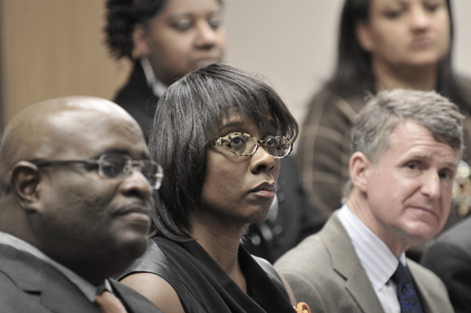| |

From left: Heaster
Wheeler, Steering Committee Member; Toni Griffin, Director
of Technical Planning Team and Rip Rapson, President and CEO
of The Kresge Foundation listen in following their
presentations at the unveiling of Detroit Future City
report. (Photo by Thomas Richardson/Tell Us Detroit) |
| |
“Detroit
City
Future”
Plans
for the
Next 50
Years
By Karen
Hudson
Samuels/Tell
Us
Detroit
DETROIT
(Tell Us
Det) -
Detroit’s
future
may
never
have
looked
brighter,
thanks
to a two
year
collaborative
effort
that
produced
the
Detroit
Future
City
report
and the
$150
million
dollars
in
support
announced
by the
Kresge
Foundation
to
finance
its
execution.
“Every
dollar
Kresge
spends
in
Detroit
over the
next
five
years
will be
dedicated
to this
plan”
said
Kresge
Foundation
President
& CEO
Rip
Rapson.
The
Detroit
Future
City
strategic
framework
was
unveiled
Wednesday
by Mayor
Dave
Bing and
a broad
coalition
of
partners
from
government,
civic,
educational
and
community
groups.
“This is
the most
comprehensive
framework
every
established
for an
American
city,”
said
Toni
Griffin,
Director
of the
Technical
Planning
Team and
a New
York
based
expert
on urban
planning.
Over a
two year
period,
some
30,000
interviews,
numerous
focus
groups
and
input
from
urban
planners,
locally
and
nationally,
all
provided
data for
planning
the
city’s
future.
Launched
as the
Detroit
Works
Project
by the
Bing
administration,
the 347
page
Detroit
Future
City
report
addresses
Detroit’s
assets,
challenges
and
opportunities
and is
intended
to guide
future
decision-making
over
next
half
century.
The long
term
plans
for the
city are
divided
into six
elements:
Economic
Growth,
Land
Use,
Neighborhoods,
Land and
Building
Assets,
City
Systems
and
Civic
Engagement,
each
with its
own set
of
recommendations.
On the
Economic
Growth
front,
the
report
says the
challenge
is to
grow a
diversified
economy,
but must
also
address
“The
need to
enhance
equity
by
creating
job
opportunities
for
Detroiters
of all
backgrounds
and
skill
levels.”
Equitable
job
growth
means
“the
explicit
recognition
and
dismantling
of
current
barriers
facing
Detroit
residents
in terms
of
access
to
skills
development
and
employment
and
entrepreneurship
opportunities”.
Today
four
“pillars”
of
employment
account
for over
fifty
percent
of
Detroit’s
employment
base:
education
and
medical
employment
(“Eds
and
Meds”),
digital
and
creative
jobs,
industrial
employment
(both
traditional
and new
technologies,
large-scale
and
artisanal,
manufacture
and
processes),
and
local
entrepreneurship.
The
hurdles
facing
the
pillars
of
economic
growth
include
this
fact.
“The
city has
only 27
jobs per
100
residents”.
By
comparison
Denver
has 80
jobs per
100
residents.
“Of the
top 100
Cities
only 5
have
fewer
jobs per
resident”
according
to the
Detroit
Future
City
report.
Establishing
employment
districts
in
already
viable
sectors
of the
city is
a
recommendation
the
report
has to
begin
addressing
this
challenge.
Recommendations
that
address
land use
are
visionary
but
possible.
The
report
sees
improving
the
quality
of life
by
transforming
vacant
land
into
carbon
forests
and
water
retention
ponds to
achieve
better
health
and
beautify
the
city.
Mayor
Bing and
all
partnering
groups
in the
Detroit
Future
City
project
stressed
community
engagement
as
essential
in
moving
city’s
future
forward.
A copy
of the
report
is
available
online
at
www.http://detroitworksproject.com/
|